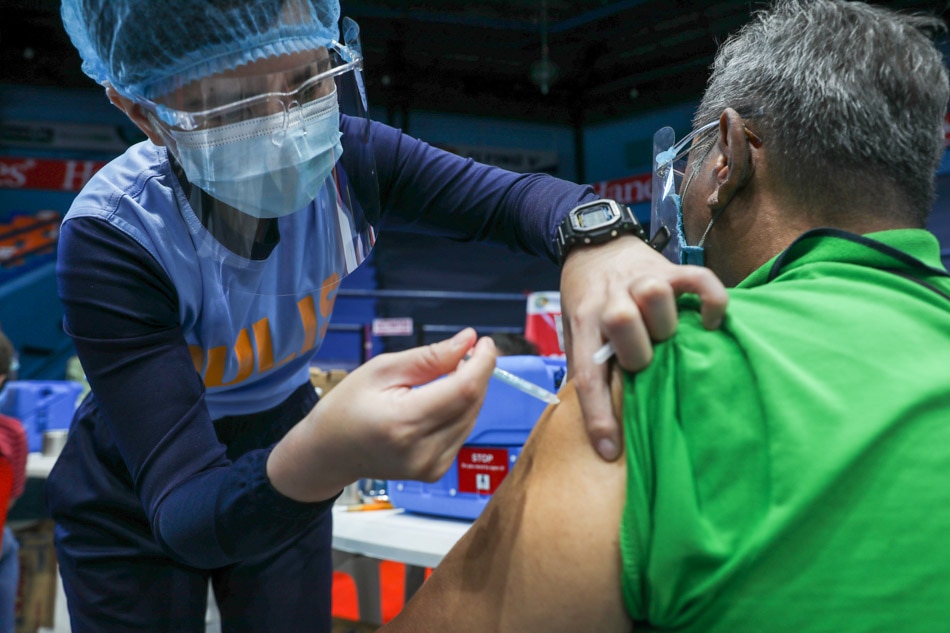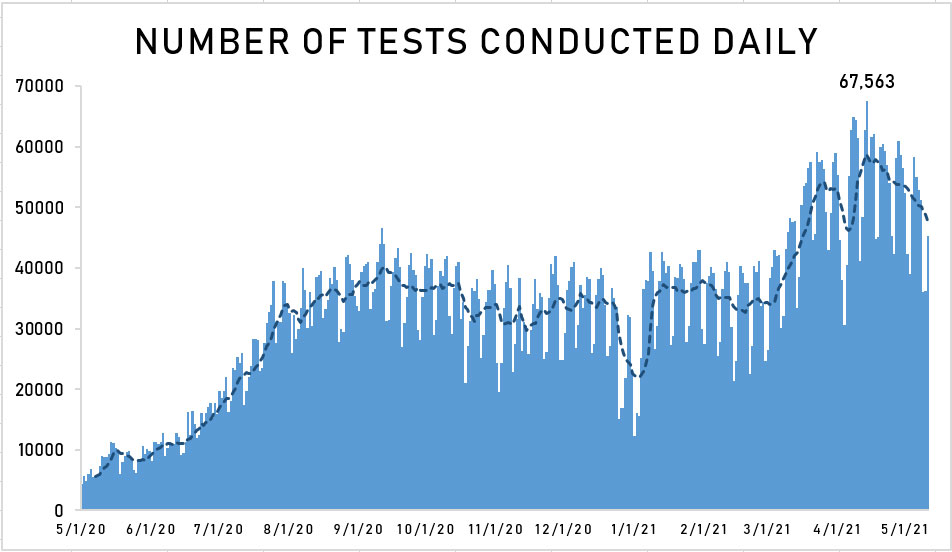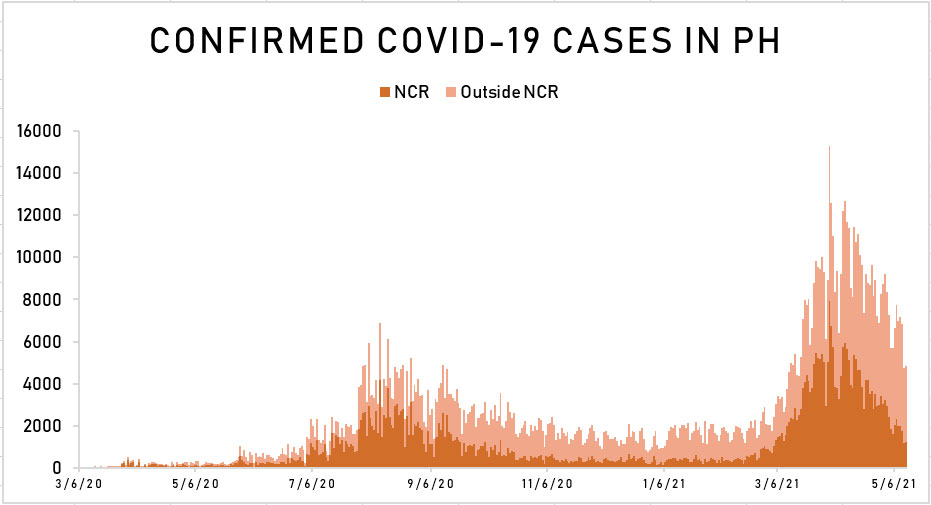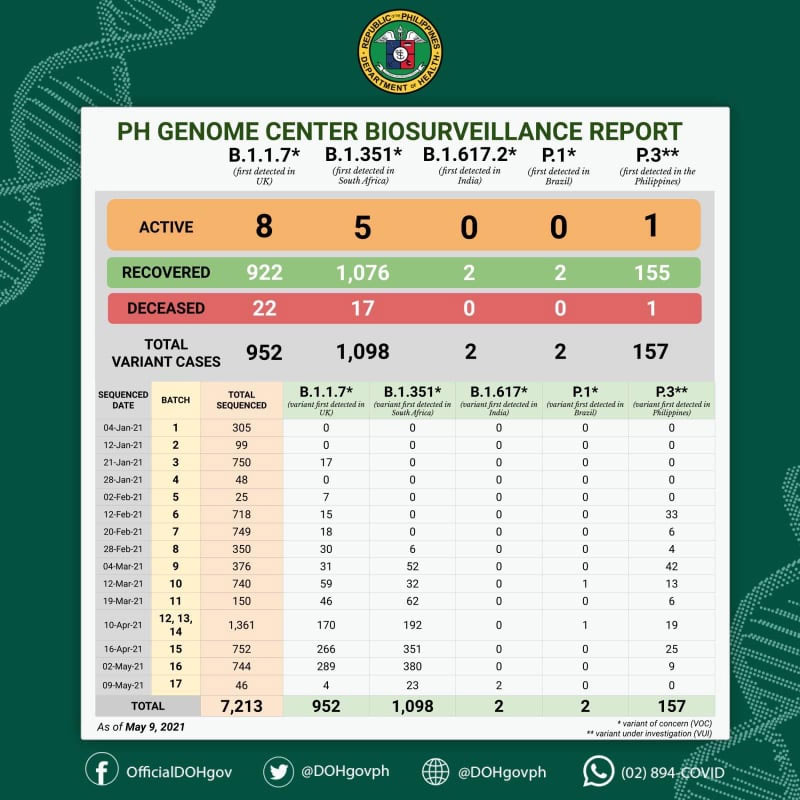Dissecting Data: Are COVID-19 cases finally coming down in the Philippines? | ABS-CBN

Welcome, Kapamilya! We use cookies to improve your browsing experience. Continuing to use this site means you agree to our use of cookies. Tell me more!
Dissecting Data: Are COVID-19 cases finally coming down in the Philippines?
Dissecting Data: Are COVID-19 cases finally coming down in the Philippines?
Warren de Guzman and Edson Guido,
ABS-CBN News
Published May 13, 2021 02:51 PM PHT
|
Updated May 13, 2021 03:26 PM PHT
The Philippine government is once again hinting at easing lockdown restrictions following a drop in new COVID-19 cases. The Philippines has been here before, and sadly lighter lockdown conditions eventually led to the 2021 spike, the worst for the Philippines during this pandemic. Is now the right time to ease restrictions?
MANILA -- Socioeconomic Planning Secretary Karl Kendrick Chua said there are signs of an opening for the lifting of restrictive quarantine conditions. He said this while delivering news on the 5th straight quarter of contraction of the Philippine economy amid the global COVID-19 pandemic. His goal was obviously to boost confidence in the economy, and the still nascent recovery.
Was he right?
MANILA -- Socioeconomic Planning Secretary Karl Kendrick Chua said there are signs of an opening for the lifting of restrictive quarantine conditions. He said this while delivering news on the 5th straight quarter of contraction of the Philippine economy amid the global COVID-19 pandemic. His goal was obviously to boost confidence in the economy, and the still nascent recovery.
Was he right?
DOH reports 4,842 new cases today. This brings the total to 1,118,359 cases with 53,214 active.
94 new deaths, 18,714 total
8,312 new recoveries, 1,046,431 total
The number of active cases is the lowest since March 14 ✅ pic.twitter.com/29yEMSxEl9
— Edson (@EdsonCGuido) May 12, 2021
DOH reports 4,842 new cases today. This brings the total to 1,118,359 cases with 53,214 active.
— Edson (@EdsonCGuido) May 12, 2021
94 new deaths, 18,714 total
8,312 new recoveries, 1,046,431 total
The number of active cases is the lowest since March 14 ✅ pic.twitter.com/29yEMSxEl9
The latest data from the Philippine Department of Health showed a clear decline in confirmed COVID-19 cases, after the peak experienced in April. The average for the last week was 6,418 cases per day. This is significantly lower than the 11,000 daily average from April 9 to 15. In this respect, Chua was right. However, daily confirmed cases in January and February averaged less than 1,800 a day. Daily cases have improved, but they have not fallen to acceptable levels, and are still much higher compared to 2020.
The latest data from the Philippine Department of Health showed a clear decline in confirmed COVID-19 cases, after the peak experienced in April. The average for the last week was 6,418 cases per day. This is significantly lower than the 11,000 daily average from April 9 to 15. In this respect, Chua was right. However, daily confirmed cases in January and February averaged less than 1,800 a day. Daily cases have improved, but they have not fallen to acceptable levels, and are still much higher compared to 2020.
An acceptable level, as defined by the World Health Organization (WHO), is a COVID-19 positivity rate of 5 percent or lower for at least two weeks. There has been a decline in the positivity rate, from 20.7 percent in the first two weeks of April (including the peak of 25.2 percent on April 2) to 14.7 percent over the last two weeks. However, that is still three times the recommended level of the WHO, and more severe than some of the peaks of last year.
An acceptable level, as defined by the World Health Organization (WHO), is a COVID-19 positivity rate of 5 percent or lower for at least two weeks. There has been a decline in the positivity rate, from 20.7 percent in the first two weeks of April (including the peak of 25.2 percent on April 2) to 14.7 percent over the last two weeks. However, that is still three times the recommended level of the WHO, and more severe than some of the peaks of last year.
The positivity rate measures the number of positive COVID-19 individuals against the number of individuals tested. The higher number of tests, the more accurate the data. More testing also tends to reduce the positivity rate, provided less positive cases are confirmed. Testing ramped up in April, hitting a pandemic high of 67,563 on April 14. This helped confirm the spike in March and April, and convinced the Duterte administration to pull the trigger and maintain tighter quarantines. Unfortunately, the number of tests declined after April 14, and the testing has yet to exceed 60,000 a day this May.
The positivity rate measures the number of positive COVID-19 individuals against the number of individuals tested. The higher number of tests, the more accurate the data. More testing also tends to reduce the positivity rate, provided less positive cases are confirmed. Testing ramped up in April, hitting a pandemic high of 67,563 on April 14. This helped confirm the spike in March and April, and convinced the Duterte administration to pull the trigger and maintain tighter quarantines. Unfortunately, the number of tests declined after April 14, and the testing has yet to exceed 60,000 a day this May.
ADVERTISEMENT
ABS-CBN Data Analytics from DOH data
Average daily number of tests in April = 54,077
Average daily number of tests from May 1 to 11 = 47,341
ABS-CBN Data Analytics from DOH data
Average daily number of tests in April = 54,077
Average daily number of tests from May 1 to 11 = 47,341
Less tests mean less accurate data. The Health Department acknowledged this as a real problem. However, daily testing totals over the last two weeks are much improved compared to 2020 levels.
Less tests mean less accurate data. The Health Department acknowledged this as a real problem. However, daily testing totals over the last two weeks are much improved compared to 2020 levels.
Meanwhile, regional COVID-19 data showed improvements in positivity rates over the last two weeks in key locations. The National Capital Region (NCR) averaged 14.5 percent, slightly below the national average, and much lower compared to the 23.8 percent average in the first two weeks of April. That rate meant 1 out of 4 people tested turned out positive for COVID-19 in early April.
Regions 3 and 4A, Central Luzon and CALABARZON averaged a positivity rate of nearly 20 percent during the same time frame. These were also improvements from April levels, but are still four times the WHO’s recommended level.
Meanwhile, regional COVID-19 data showed improvements in positivity rates over the last two weeks in key locations. The National Capital Region (NCR) averaged 14.5 percent, slightly below the national average, and much lower compared to the 23.8 percent average in the first two weeks of April. That rate meant 1 out of 4 people tested turned out positive for COVID-19 in early April.
Regions 3 and 4A, Central Luzon and CALABARZON averaged a positivity rate of nearly 20 percent during the same time frame. These were also improvements from April levels, but are still four times the WHO’s recommended level.
More importantly, only Regions 7 (Central Visayas) and 11 (Davao Region) registered positivity rates close to the WHO benchmark of 5 percent.
More importantly, only Regions 7 (Central Visayas) and 11 (Davao Region) registered positivity rates close to the WHO benchmark of 5 percent.
More testing would have given a more accurate picture, and Region 4B (MIMAROPA) is a perfect example. The region tested less than 200 individuals a day in the past two weeks and that resulted in a near 50 percent positivity rate. That meant 1 in every 2 people tested were positive for COVID. On May 9, the positivity rate for Region 4B was at 65 percent. More testing is needed there.
More testing would have given a more accurate picture, and Region 4B (MIMAROPA) is a perfect example. The region tested less than 200 individuals a day in the past two weeks and that resulted in a near 50 percent positivity rate. That meant 1 in every 2 people tested were positive for COVID. On May 9, the positivity rate for Region 4B was at 65 percent. More testing is needed there.
Secretary Chua said the signs of an opening to ease restrictions cover the economically important National Capital Region. 1,793 confirmed COVID-19 cases were reported in the NCR over the past week, 32 percent lower than the week before, faster than the 16 percent decline at the national level in the same period. NCR cases have also dropped 68 percent from the 5,548 a day average between March 29 and April 4. That was also much faster than the national decline.
Secretary Chua said the signs of an opening to ease restrictions cover the economically important National Capital Region. 1,793 confirmed COVID-19 cases were reported in the NCR over the past week, 32 percent lower than the week before, faster than the 16 percent decline at the national level in the same period. NCR cases have also dropped 68 percent from the 5,548 a day average between March 29 and April 4. That was also much faster than the national decline.
NCR cases also accounted for 32 percent of the national total over the last two weeks. This was lower compared to the 49 percent share in the first 2 weeks of April.
NCR cases also accounted for 32 percent of the national total over the last two weeks. This was lower compared to the 49 percent share in the first 2 weeks of April.
However, we have to consider that daily cases in Metro Manila averaged less than 500 a day in January up to mid-February this year. The positivity rate was also below 5 percent during that period. More work needs to be done to return to that level.
However, we have to consider that daily cases in Metro Manila averaged less than 500 a day in January up to mid-February this year. The positivity rate was also below 5 percent during that period. More work needs to be done to return to that level.
The positivity rates of the adjacent Central Luzon and CALABARZON regions were also much higher. Portions of these regions were included in the so-called NCR-plus bubble. All three regions put together make up nearly 60 percent of the Philippine economy. They are highly integrated.
The positivity rates of the adjacent Central Luzon and CALABARZON regions were also much higher. Portions of these regions were included in the so-called NCR-plus bubble. All three regions put together make up nearly 60 percent of the Philippine economy. They are highly integrated.
Meanwhile, the DOH has demonstrated a limited capacity to track COVID-19 variants in the Philippines. The variant data presented to the public has been limited. The latest batch showed only 46 samples were sequenced out of thousands of new COVID-19 cases confirmed per day. The total number of samples which were genome sequenced was at 7,213 as of May 9. That is a fraction of this year’s daily testing. Of those samples sequenced, 2,211 were confirmed as variant cases. Only 14 are active, with most declared as either recovered or dead. This clearly indicates that there is a delay in the monitoring. Factors which contributed to the inconclusive data may include cost and capability.
Meanwhile, the DOH has demonstrated a limited capacity to track COVID-19 variants in the Philippines. The variant data presented to the public has been limited. The latest batch showed only 46 samples were sequenced out of thousands of new COVID-19 cases confirmed per day. The total number of samples which were genome sequenced was at 7,213 as of May 9. That is a fraction of this year’s daily testing. Of those samples sequenced, 2,211 were confirmed as variant cases. Only 14 are active, with most declared as either recovered or dead. This clearly indicates that there is a delay in the monitoring. Factors which contributed to the inconclusive data may include cost and capability.
The existing data from the Philippine government revealed improvements in positivity and daily confirmed cases in the National Capital Region. However the data still came with caveats, such as lower testing totals. Other regions highly integrated with NCR have also lagged in terms of positivity and daily cases reported. The tracking of COVID-19 variants has also been limited. A case can be made for lighter quarantine conditions, but it can also be argued that COVID-19 is still a bigger problem now than when the government started easing quarantine levels last year.
The existing data from the Philippine government revealed improvements in positivity and daily confirmed cases in the National Capital Region. However the data still came with caveats, such as lower testing totals. Other regions highly integrated with NCR have also lagged in terms of positivity and daily cases reported. The tracking of COVID-19 variants has also been limited. A case can be made for lighter quarantine conditions, but it can also be argued that COVID-19 is still a bigger problem now than when the government started easing quarantine levels last year.
RELATED VIDEO:
Read More:
coronavirus
COVID-19
analytics
Philippine economy
recession
Karl Chua
NEDA
quarantines
lockdown
variants
ADVERTISEMENT
ADVERTISEMENT







